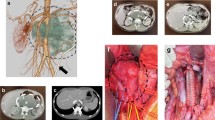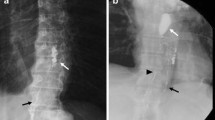Abstract
Background
Ligation of thoracic duct is the standard procedure currently used to prevent postoperative chylothorax for patients undergoing esophagectomy when thoracic duct is surgically injured or invaded by tumor. However, preservation of lymphovenous circulation is particularly important for a subset of patients, including individuals with liver cirrhosis, ascites, nephrotic syndrome, sclerosing mesenteritis, or some cardiac conditions.
Methods
We have developed a new technique of restoring lymphovenous circulation for patients undergoing esophagectomy. Intrathoracic lymphovenous anastomosis was performed for an esophageal cancer patient by intravenous catheter assisted end-to-side “insertion” technique.
Results
The time taken for lymphovenous anastomosis was 35 min. No massive bleeding or other adverse events occurred during operation, and the patient had an uneventful postoperative course. Lipid metabolisms, assessed by pre- and postoperative plasma concentrations of cholesterol, triglycerides, high-density and low-density lipoprotein, were not affected after lymphovenous anastomosis. Lymphangiography also indicated lymphovenous anastomosis remained patent 3 years after operation. No long-term surgery-related adverse events were observed during 3-year follow-up.
Conclusion
Lymphovenous anastomosis was successfully implemented for the patient with esophagectomy, selected patients might benefit from this novel technique.


Similar content being viewed by others
References
Liu JP, Zhang YH, Yang B et al (2015) Influence of thoracic duct ligation on the lipid metabolism of patients with esophageal carcinoma after esophagectomy. Genet Mol Res 14:2527–2536
Romero S, Martín C, Hernandez L et al (1998) Chylothorax in cirrhosis of the liver: analysis of its frequency and clinical characteristics. Chest 114:154–159
Rice BL, Stoller JK, Heresi GA (2010) Transudative chylothorax associated with sclerosing mesenteritis. Respir Care 55:475–477
Cakmak HA, Yenidünya G, Karadağ B et al (2011) Development of chylothorax and chylous ascites in a patient with congestive heart failure. Turk Kardiyol Dern Ars 39:495–498
Riza Altiparmak M, Avsar S, Yanik S (2004) Chylous ascites and chylothorax due to constrictive pericarditis in a patient undergoing haemodialysis. Neth J Med 62:59–61
Author information
Authors and Affiliations
Corresponding author
Rights and permissions
About this article
Cite this article
Yuan, Y., Chen, Lq. & Zhao, Y. Anastomosis Between Thoracic Duct and Azygos Vein During Esophagectomy: A Novel Technique with 3-year Follow-up. World J Surg 40, 2984–2987 (2016). https://doi.org/10.1007/s00268-016-3666-z
Published:
Issue Date:
DOI: https://doi.org/10.1007/s00268-016-3666-z




